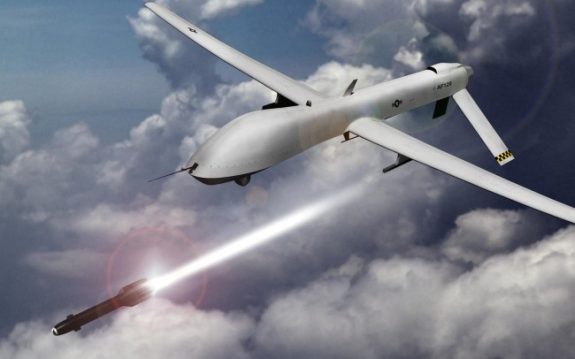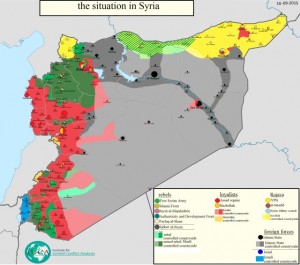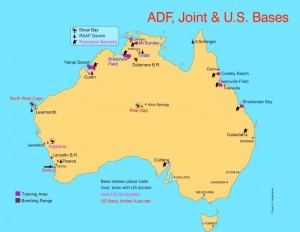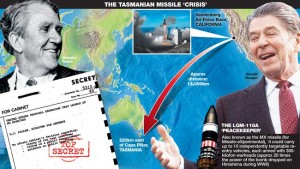Talking up Australia’s Middle Power Diplomacy

By Denis Bright
What are the implications for Australian sovereignty of the broadening and strengthening of commitment to the Australia US military alliance in The Post 9/11 Era?
From a security oriented arrangement between sovereign states under the ANZUS Treaty of 1951, the Alliance has evolved into complex whole of government accords which extend from traditional defence links to incorporate stronger security, economic and cultural ties.
Both countries share a commitment to market-based development, a low taxation base for the delivery of non-military government services as well as the expected long-standing commitments to mutual defence within an increasingly predictable template model of Australian politics.
Application of this wider template model in both Australia and the US has already brought widespread disenchantment with mainstream politics.
After five Prime Ministers since 2007, many Australians are not really comfortable with a society that is being restructured on Anglo-American lines.
Even in the US itself, this style of neo-conservatism has imposed an appalling income divide, falling real wages and real sectors of disadvantage.
This is hardly exportable as a model political system.
Australian lobbyists now talk up the profile of business corporations, the enduring role for the armed forces or the need for more law enforcement and domestic security. These establishment voices are echoed in most of the print media and eyewitness news reporting.
Welcome to the template world of Australian politics with its financial limits on the delivery of essential infrastructure and services despite ongoing commitments to overseas military deployments.
In reconstructions of Australian history in the mainstream media, images of military deployments have long triumphed over attention to the domestic political struggles for social justice in a more inclusive social market economy. Indeed by 1915, Australians had twice elected a national social democratic government with a majority in both houses of parliament.
The Australian electorate also voted on two occasions to reject the need for conscription to the Western Front in Europe in 1916-17.
The template of public sector austerity does not of course extend to the outreach of the US Global Alliance.
Joint and US Base facilities in Australia are now well entrenched.
Australia’s current involvement in joint military exercises means that our military commanders must decide spontaneously when an exercise becomes fully operational.
SBS news updates warn of possible offensive involvement of the Pine Gap Joint Communication Base in the targeting of US drone strikes from Pakistan to the Horn of Africa.
Australia’s proactive involvement within the US Alliance also includes commitment to the political stabilization of the adjacent Asia Pacific Region.
The greatest local regional challenge for Australia is steering Indonesia away from its long-term non-aligned status towards a greater association with allied countries in domestic counter-terrorism and towards a more critical stance on the rise of China as a military power in the South China Sea.
The military profile of the US in Indonesia has risen under President Obama. While Indonesia maintains its military ties with major international arms suppliers, the US Defense News applauds the increasing focus on US suppliers as well as military training programmes from Australia and the US.
During a sensitive phase in Australian Indonesian relations over the fate of Andrew Chan and Myuran Sukumaran, the Chairman of the US Joint Chiefs of Staff, General Martin Dempsey, called for closer military co-operation between the armed forces of Australia and Indonesia.
Such poorly-timed strategic advice accompanied by lobbying for the purchase of Reaper drones by Australia would not have been welcome in earlier stages of the ANZUS Treaty of 1951 with its insistence on constitutional processes to protect Australian sovereignty.
Historical background: Australia as a stable democratic frontier within the US Alliance
The suffocating conformity to the demands of the US Alliance was not just imposed upon Australia by successive US administrations. This has always been a trump card in the LNP’s domestic political arsenal.
Prime Minister Harold Holt won a sweeping victory at the national election on 26 November 1966 after a pre-arranged tour by President Johnson was conveniently slotted into the last days of the national election campaign.
The election was largely a referendum on the merits of Australia’s support for the US Alliance in South Vietnam. The LNP received its best primary vote since 1934 to that date.
Under the leadership of Gough Whitlam as both Opposition Leader and Prime Minister, the electorate was able to become more critical of The All the Way with LBJ Mantra of 1966.
With the election of Prime Minister Fraser in 1975, Australia returned to its old dependent status within the Alliance.
During a spike in the Cold War, Malcolm Fraser and Ronald Reagan negotiated the symbolic involvement of Australia in testing the accuracy of MX Missiles fired from Vandenberg Air Force Base in California.
Labor’s return under Prime Minister Bob Hawke in 1983 brought a government with power sharing between the dominant right groups and various left factions. At the grassroots level, peace and disarmament groups had a big following. There was strong sympathy in both the Labor caucus and the wider community for the bans on US nuclear powered or nuclear armed naval vessels by the New Zealand Government.
Prime Minister Hawke faced a potential revolt within the Labor caucus over the continuation of the Fraser Government’s MX missile test protocols as arranged by the previous government. Bob Hawke was able to defuse the caucus problems with a complex series of brilliant Win Win manoeuvres.
Australia withdrew from a non-essential direct involvement in the MX Missile tests. This permitted Prime Minister Hawke to talk up opposition to New Zealand’s embargo on either nuclear powered or nuclear armed vessels.
With New Zealand excluded from active participation in the ANZUS Treaty, Australia proceeded to professionalise security consultations with the US through the formation of the Australia-US Ministerial Council (AUSMIN) in 1985.
The US Embassy in Canberra still maintains an eloquent interpretation of AUSMIN arrangements.
Held regularly since 1985, the AUSMIN talks provide a valuable opportunity for Australian and U.S. officials to discuss a wide range of global, regional and bilateral issues.
Embassy of the US, Canberra 2015 (http://canberra.usembassy.gov/irc/us-oz/ausmin.html)
The new arrangements were a big win for the US in widening the scope of visits by US nuclear powered ships and the transportation of nuclear weapons through Australian ports.
After a senate inquiry in 1988, the prevailing centre-right majority within the Hawke Government was prepared to live with the consequences of nuclear incidents in Australian ports:
The US has confirmed to us that in all routine peacetime circumstances, US naval weapons are securely and safely stowed in an unarmed condition where they are protected from fire and electrical activity. The US Navy’s safety procedures take full account of the risks arising from sources of electromagnetic radiation as well as unauthorised access being gained to the nuclear weapons…The nuclear material in modern nuclear weapons is kept together with the other components of the weapon at all times. This does not however affect the possibility that a nuclear weapon accident might occur or that accidental nuclear detonation might eventuate.
Letter from the Minister for Defence, the Hon. Kim Beazley (1988) as tabled at the Senate Inquiry into Visits to Australia by nuclear powered or armed vessels
Even during the Republican Presidencies of Ronald Reagan (1980-88) and George H. W. Bush (1988-92), there seemed to be few objections to specific assertions of Australian independence in defence and foreign policy issues.
However, the events of 9/11 rekindled the old spirit of Australian dependence within the US Alliance. Prime Minister Howard had debts to repay to the US for its diplomatic support for Australia’s intervention in East Timor in 1999. The electorate was also ready to accept the threat of Jihadi terrorism as a viable substitute for the perils of perceived communist threats in the Cold War Era.
The Australia US Alliance in the Post 9/11 Era
This rekindled Australia US Alliance in The Post 9/11 Era was qualitatively different from the Cold War ANZUS treaty of 1951. It is now more deeply embedded in US economic diplomacy to consolidate the more strident financial leadership roles of the US and its key allies in the management of global capitalism.
Latest corporate data from the McKinsey Global Institute, shows the relative success of US economic diplomacy in recovering from the effects of the Global Financial Crisis (GFC).
With a mere 14% of corporate profits, Chinese firms were hardly a threat to the dominant western multinational brands.
Associate Professor Ho-Fung Hung at John Hopkins University made an appropriate interpretation of the still dependent status of China in the global economy. His article entitled America’s Head Servant: The PRC in the Global Crisis is readily available.
There is of course a longer term strategic risk for the US if China develops a more effective global financial outreach within an alternative brand of social market capitalism with obvious appeal to the developing world as a more altruistic form of capitalism.
US strategists must be comforted by the positive drift in corporate profits to industries associated with research and development, corporate communication, software and algorithms. These are in the economic sectors of pharmaceuticals, media, finance and information technology. All these commercial achievements are reinforced by the close co-operation between the business sectors of the US and those of its key allies.
New financial hubs are crucial in maintaining the financial supremacy of the western model of global capitalism. The Australia US Free Trade Agreement (AUSFTA), the Trans Pacific Partnership (TPP) and the forthcoming Transatlantic Trade and Investment Partnership (TTIP) between the US and European Union (EU) countries are all crucial milestones in the consolidation of US economic diplomacy.
Prime Minister Turnbull is still committed to the neo-conservative policy template of market based economic development, less commitment to direct government intervention, a low taxation base and unswerving loyalty to the US in defence and foreign policy commitments.
President Obama’s current charismatic style has made it somewhat easier to promote the template model of market-based politics since 2008. Australians must also anticipate less predictable changes in US Global Alliance Systems in the event of another neo-conservative Republican administration with more assertive foreign and defence policies.
Australia’s successful record in Middle Power Diplomacy
Earlier generations of Australian leaders could afford to be more even-handed about the direction of the US Alliance.
The Hawke Government was factionally broad enough to accommodate some token changes in Australia’s relationship with the US.
US control over the renamed Joint Defence Facility at Pine Gap became slightly more accountable after 1988.
Even some meetings of the Joint Standing Committee on Intelligence and Security were hosted at Pine Gap Base during the Rudd-Gillard years. No minutes of the deliberations were published on the Australian parliamentary site.
Senator Gareth Evans as foreign minister (1988-96) became the outstanding architect of the Cambodian Peace Plan of 1989.
The plan was a UN sponsored initiative. It brought together all four Cambodian factions, the six ASEAN countries, the Permanent Five Members of the UN Security Council, Vietnam, Laos, Australia, Canada and India as well as Zimbabwe (representing the Non-Aligned Movement) and a representative of the UN Secretary-General.
This moved Cambodia from an ongoing security and humanitarian crisis to a broader peace initiative under UN auspices.
Andrew Peacock as Foreign Affairs Minister in the Fraser Government broke with the US in withdrawing diplomatic recognition from the remnants of the Pol Pot Regime which soon lost all its significant territorial controls after the Vietnamese occupation of Cambodia from late 1978.
Some parallels with the current Syrian crisis must be noted.
President Obama has now incorporated the positive achievements of German diplomacy from an innovative Middle Power within NATO.
A generation ago, Gareth Evans also proposed that Middle Powers like Australia could make a substantial contribution to peace and disarmament which is largely off the radar in Australian politics.
All these commitments have been overshadowed by the international politics of The Post 9/11 Era.
Instead of confronting Israel for its failure to sign the Nuclear Non-Proliferation Treaty or international protocols against the use of chemical and biological weapons, Australia under the LNP could not even support the highly symbolic gesture of allowing the Palestinian flag to be raised at the UN Building in New York.
Australia voted with the Israel, Canada, Micronesia, the Marshall Islands, Palau and Tuvalu to support the US in opposing this symbolic resolution in the General Assembly on 10 September 2015.
This isolation of Australia from mainstream world opinion extended to a reflexive commitment to support a minority of NATO in the bombing of Daesh installations in Syria while the current round of international diplomacy was in its initial stages.
With the support of other responsible middle powers like Germany, Australia could have gained traction for some alternatives to the current misery in Syria as early as 2012.
Writing in The Guardian Online on 15 September 2015, Julian Borger and Bastien Inzaurralde welcomed the new US approach to the Syrian crisis. It was interpreted as a return to the recommended negotiating stance of the UN Syrian Group of February 2012. The Elders in the group had included Nelson Mandela, Jimmy Carter and former UN Secretary General Kofi Annan.
The civil war in Syria had taken 7,500 lives by February 2012. Now the toll has already reached 250,000 with 11.5 million Syrians homeless. Four million Syrians have sought sanctuary in adjacent Middle Eastern and European countries.
Revisiting Australia’s involvement in the bombing of Daesh installations in Syria
Australia’s recent decision to follow a request from the US to become involved in the bombing of Daesh installations overlooked the complex nature of the civil war in Syria.
The conflict map shows a mosaic of misery across Syria with the government of President Assad in charge of much less than half the country.

Syrian conflict map 16 September 2015 (Syrian Observatory for Human Rights 2015 authorized by Pieter Van Ostaeyen (https://pietervanostaeyen.files.wordpress.com/2015/09/2000px-syria15.png?w=640)
Even Syria’s capital, Damascus, is besieged by a network of rebel forces with no direct links to Daesh forces. On the nearby Golan Heights, illegally placed Israeli forces stand ready to intervene in the conflict should Damascus fall to Jihadi rebel forces.
While Germany was one of the 45 countries which abstained from voting on the symbolic Palestinian flag issue in the UN General Assembly, it was not prepared to participate in the US inspired bombing of Daesh installations in Syria at this stage in the conflict.
In the interests of a pragmatic peace in Syria, Chancellor Merkel knows that there is no advantage to NATO if the Syrian capital should fall to Jihadi rebels in an absolutely failed state which may only advantage Daesh forces in the longer-term.
Besieged by refugees from war-torn Syria, the German Government supports peace initiatives to avoid the continuing conflict between the Assad Government and an array of rebel forces.
As one of the ministers in Germany’s Grand Coalition, foreign minister Frank-Walter Steinmeier (SPD) has raised the prospects of a peace initiative with Russian Foreign Minister Sergey Lavrov.
In holding off from involvement in bombing operations in Syria, Chancellor Merkel mentioned to Germany’s DW News Network that “We have to speak with many actors, this includes Assad, but others as well.” This would include “Not only with the United States of America, Russia, but with important regional partners, Iran, and Sunni countries such as Saudi Arabia.”
These German initiatives for peace in Syria are very similar to proposals from the Syrian Group which was rejected by both the US and the UK in 2012. Details are available in The Guardian Online.
It is appropriate that US Secretary of State, John Kerry and Australian Foreign Minister Julia Bishop now endorse these proposals.
Meanwhile, the Yarmouk refugee camp near Damascus is often hit in the cross fire between forces loyal to President Assad and a myriad of rebel groups.
Foreign minister Julie Bishop’s welcome change of heart on Syria is perhaps a sign of greater independence within the Australia US Alliance under the new Prime Minister.
Let’s hope that Malcolm Turnbull’s uses his understanding of contemporary globalization to review all aspects of the current template model of market-based politics which is causing so much distress in both societies.
 Denis Bright (pictured) is a registered teacher and a member of the Media, Entertainment and Arts Alliance (MEAA). He has recent postgraduate qualifications in journalism, public policy and international relations. He is interested in developing progressive public policies that are compatible with commitments to a social market model within contemporary globalization.
Denis Bright (pictured) is a registered teacher and a member of the Media, Entertainment and Arts Alliance (MEAA). He has recent postgraduate qualifications in journalism, public policy and international relations. He is interested in developing progressive public policies that are compatible with commitments to a social market model within contemporary globalization.
Like what we do at The AIMN?
You’ll like it even more knowing that your donation will help us to keep up the good fight.
Chuck in a few bucks and see just how far it goes!
Your contribution to help with the running costs of this site will be gratefully accepted.
You can donate through PayPal or credit card via the button below, or donate via bank transfer: BSB: 062500; A/c no: 10495969












